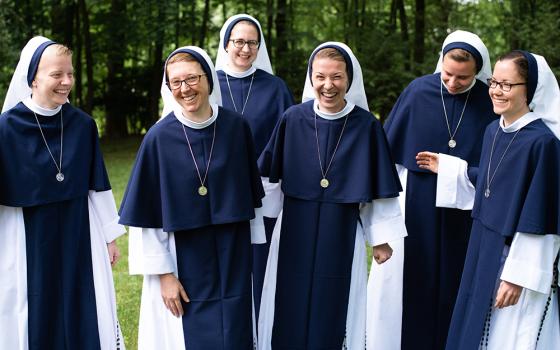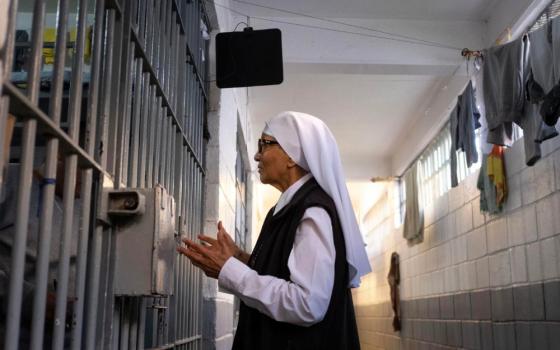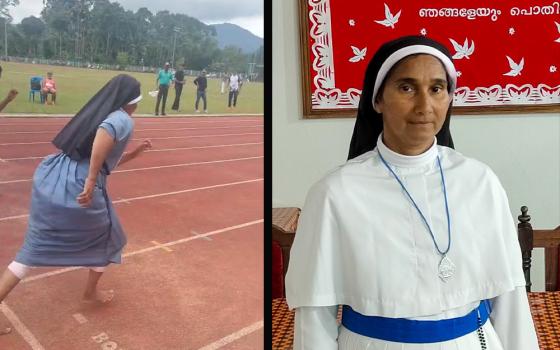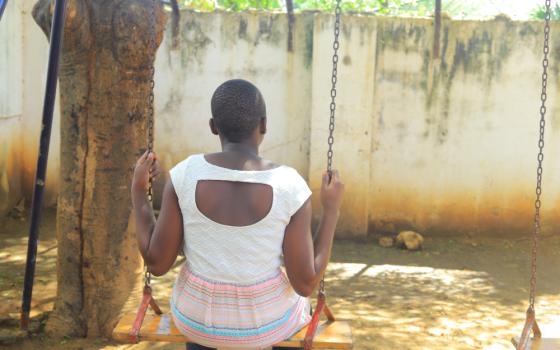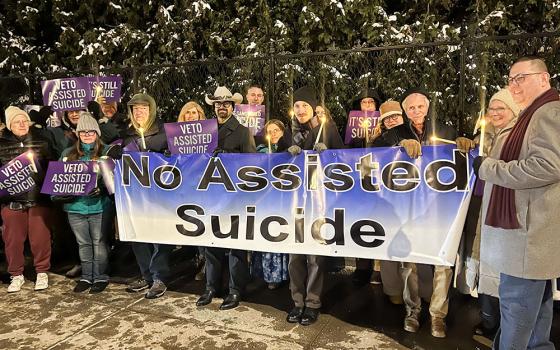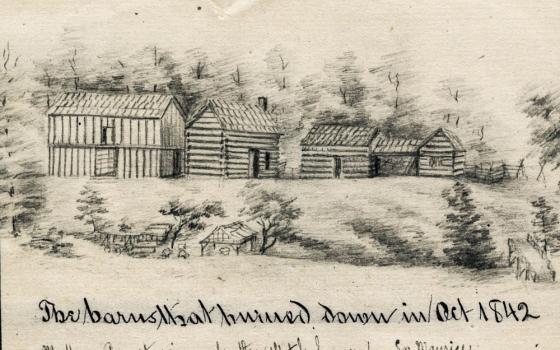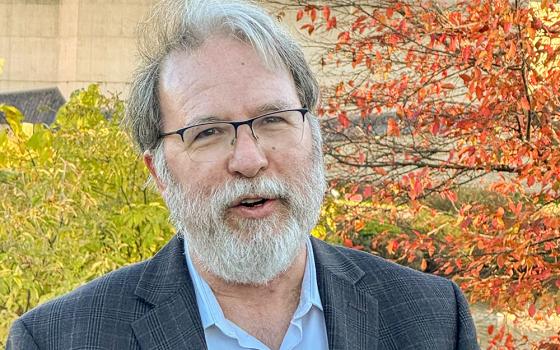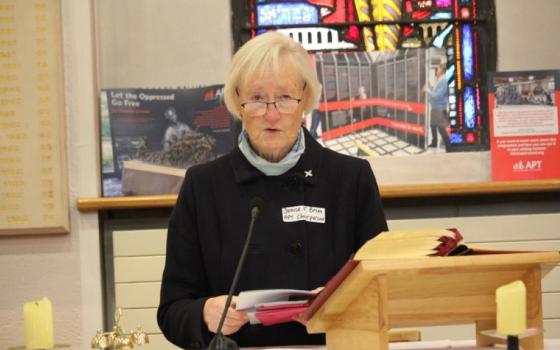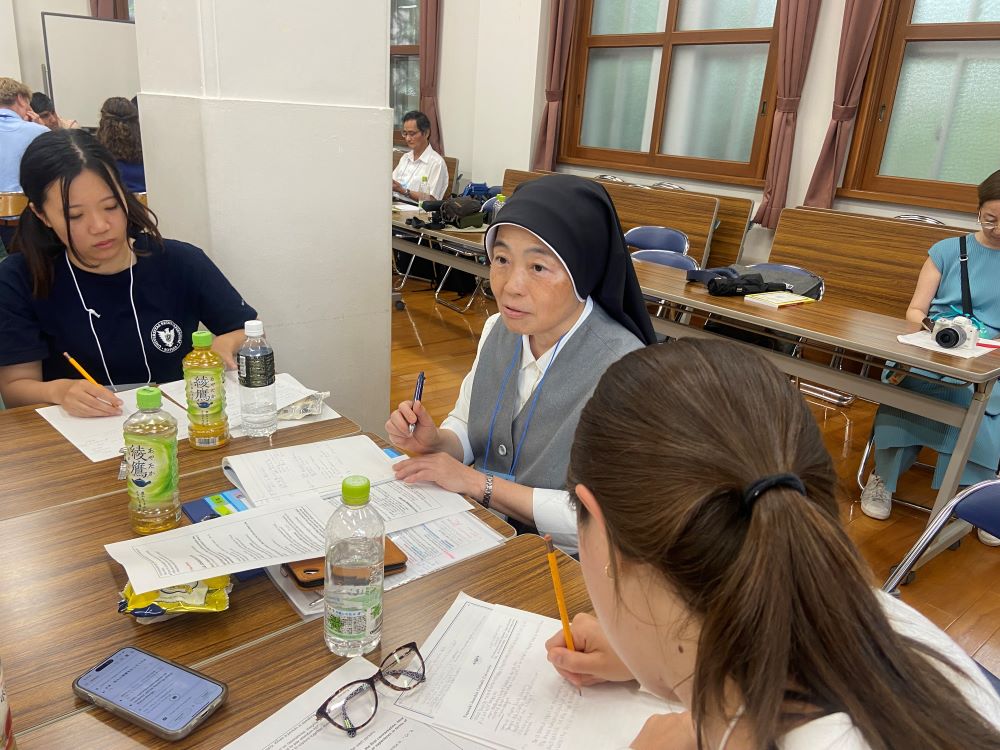
Immaculate Heart of Mary Sr. Kumiko Sakamoto facilitates a small group session during a student symposium on peace and nuclear disarmament held Aug. 10 at Junshin Girls' High School in Nagasaki, Japan. (Claire Schaeffer-Duffy)
Weeks after Nihon Hidankyo, the organization of Japanese atomic bomb survivors, received the Nobel Peace Prize in October 2024, the presidents of four Christian universities in Nagasaki, Japan, issued a joint statement in which they declared their commitment to educate for nuclear disarmament.
Signators included Sr. Kumiko Sakamoto, a sister of the Immaculate Heart of Mary, Nagasaki and president of Nagasaki Junshin Catholic University. The school recently hosted a symposium for Japanese and American students on peace and nuclear disarmament.
Global Sisters Report spoke with Sakamoto about the joint statement, Junshin's history with the atomic bomb, and its influence on her commitment to nuclear abolition.
GSR: Why did you and your colleagues issue the joint statement?
Sakamoto: There are two reasons. First to express our ultimate respect for the extraordinary efforts of Nihon Hidankyo who, as survivors of the atomic bombing, have risen from immense suffering to consistently and tirelessly [describe] the horrors of nuclear weapons and advocate for the value of peace.
Second, the current international community is facing escalating conflicts and [support] for nuclear deterrence theory, with countries opposing the Treaty for the Prohibition of Nuclear Weapons rising. As the only country to have suffered atomic bombing, Japan must reaffirm its commitment to non-nuclear principles and action toward nuclear abolition.
I really believe Japan should strongly advocate that abandonment of nuclear weapons by all nations is the only path to peace left for humanity. We hope Japan's young people will recognize this responsibility.
At the joint statement's press conference, you alone, called on Japan to ratify the Treaty for the Prohibition of Nuclear Weapons. Why did you make this public appeal?
Because Nihon Hidankyo has called for the prohibition of nuclear weapons for many years. Finally, they got a Nobel Peace Prize. This was a chance for us to amplify their message.
Maybe all Japanese feel this dilemma between [thinking] we have to be protected with nuclear weapons, like the big countries, and this point that nuclear weapons destroyed everything, especially in Nagasaki and Hiroshima. We have to say no to nuclear weapons. It's a delicate issue. As a political matter, we could not say a lot in front of the politicians, because Japan wants the protection that nuclear weapons would provide.
I feel this dilemma, but I think the best way to make a peaceful world is to abolish all the nuclear weapons.
The joint statement notes that all four universities "suffered direct and indirect losses and devastation from the atomic bombings." What were these for Junshin?
The loss of 214 students who perished, and the complete destruction of the school and convent by the atomic bomb were devastating.
In particular, the loss of 214 students caused Sr. Yasu Ezumi, the first principal of Junshin High School, to suffer deeply for the rest of her life, plagued by feelings of guilt. [She considered closing the high school.] However, parents of the deceased students pleaded with Sister Ezumi to continue the school, citing that their daughters had passed away saying prayers and singing hymns they had learned at Junshin High School, and expressing their gratitude.
This became a decisive factor in Sister Ezumi's resolve to continue the school. [In 1970], she established the Megumi-no-Oka (which means Hill of Grace) Nagasaki Atomic Bomb Home, the atomic bomb nursing home for the elderly next to Junshin Catholic University, to care for the elderly parents of the deceased students. As superior general of our order, she added care for elderly atomic bomb survivors to our educational work and apostolic mission.
Were the students at school when the bomb was dropped?
No. They were working in a munitions factory, in which older students had to work at that time. Our school had dormitories. During summer vacation, students could go back to their homes, especially those who lived far away. But most had to work in the Mitsubishi factory next to our high school. In this area, we had a convent, the school. It was about 1,200 meters from the [bomb's] hypo center.
Junshin Girls' High School school four years after the bombing of Nagasaki on Aug. 9, 1945 (Courtesy of Junshin Girls' High School)
Why did Sister Ezumi feel guilty, if the students were killed outside of school?
There was another factory far from the high school [to which Junshin students were assigned]. Sister asked the person in charge [of student mobilizations] to change their factory to one near to our school. In case there was an emergency, [the sisters] could rush to the students to help them escape from the fire. She wanted to be at the side of the students. But this factory [near Junshin] was destroyed directly while other factories were safe. So she felt very guilty.
Sister Ezumi was working in the principal's room at the high school when the atomic bomb exploded. All of the school buildings were destroyed. She was [trapped] underneath near a building that caught fire. Fortunately, one man helped her escape from the fire and brought her to the mountain where we now have our university. It is called Hill of Grace, named by Sister Ezumi because it is the place where she and other sisters, teachers and students were cared for and where we found the light to go ahead as a school and nursing home.
After she found a way to restart the school and build the nursing home for the deceased students' parents [Ezumi's] guilt disappeared little by little. Her energy to continue her apostolic work was a way to find a light to make peace.
You were crying recounting Ezumi's story. Did you know her?
I decided to become a sister when I was 13 years old. My parents said, "No, it's too early. Please wait until you are at least 20 years old. But I said, "No, I want to be a sister." Because in that year, I met Sister Ezumi for the first and last time. She was in front of the chapel. I met her by accident. I said, "Hello, sister. Nice to meet you. I am Kumiko."
Shizuko Mori, a Junshin Girls' High School student in the 1940s (Courtesy of Junshin Girls' High School)
"Oh, Kumiko, be a sister. Work with me." she said. She was a very kind woman, full of smiles. I was so impressed by her smile and calm manner. It was a very shocking moment. I decided then to be a sister. I wanted to work with her, but unfortunately, she suffered from cancer and died the next year.
Junshin University's commitment to peace education seems rooted in ensuring your students know the stories of war.
As our atomic bomb survivors age, students are becoming increasingly aware of their mission to inherit and convey their messages to younger generations and the world.
The university is currently focusing its efforts on collaborating with the atomic bomb nursing home for the elderly to provide students with as many chances as possible to hear the firsthand accounts of atomic bomb survivors.
In my class, I emphasize the importance of world peace without nuclear weapons. I tell Junshin's history [with the atomic bomb] to the first-year students on up, so that when they graduate, they will know what the sisters and other students experienced and suffered.
The Our Lady of Mercy statue is a memorial tombstone for the students, teachers and staff members of Junshin Girls' High School who were killed by the atomic bombing of Nagasaki on Aug. 9, 1945. (Courtesy of Nagasaki Junshin Catholic University)
I always urge the students to do something for the abolition of nuclear weapons. Maybe it's difficult to act at first, but from a very little point please start something.
We have a student group called Green Pieces in which students can serve as peace guides in the city and talk about Nagasaki, the history of the atomic bomb, Hidankyo, many things.
Do you think your girlhood encounter with Ezumi influenced your strong commitment to nuclear disarmament?
Yes, of course. At the time, I didn't think about the atomic bomb or war. Thinking back to the moment, maybe she wanted to initiate something in me.
As an educator who experienced the atomic bombing, she instilled a desire for lasting peace in the very foundation of her education program at Junshin. I feel that special vocation was passed to me, especially when I became president.
I decided to speak in a loud voice to the students about the importance of world peace. I would have done this even if I had become president of Kagoshima Junshin Catholic University or Tokyo Junshin Catholic University. Maybe running through the bottom of our congregation is the stream of seeking peace. Peace through nuclear abolition.
Advertisement

